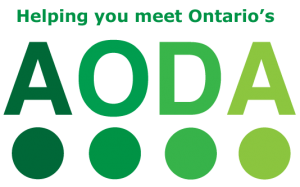This section explores different assistive and accessible technologies organized under the following categories:
- Alternative Control: these built-in features and technologies assist with controlling computers, tablets, and mobile devices.
- Alternative Display: these built-in features and technologies help convey information that is displayed on computers, tablets, and mobile devices visually or through auditory or tactile feedback.
- Augmentative Processing: these built-in features and technologies assist individuals with the understanding of information they are receiving from or inputting into computers, tablets, and mobile devices. Augmentative processing may also help accomplish tasks with less typing and quicker completion time.
What is the difference between assistive technology and accessible technology?
Assistive technology
Assistive technology is usually a piece of technology (software or hardware) designed to perform a specific task. For example, a braille keyboard to support an individual who reads braille, screen reader software that reads content out loud from digital text such as the text found here on the SNOW website, or speech-to-text software that enable people to use their voices to enter text into a word processing document.
According to the Family Guide to Assistive Technology (The Federation for Children with Special Needs and Parents, Let’s Unite for Kids), assistive technologies are useful for educators, staff and students when it does any or all of the following:
- Enables you to perform functions that can be achieved by no other means
- Enables you to approximate normal fluency, rate, or standards–a level of accomplishment which could not be achieved by any other means
- Provides access for participation in programs or activities which otherwise would be closed to you
- Increases endurance or ability to persevere and complete tasks that otherwise are difficult to be attempted on a routine basis
- Enables you to concentrate on learning tasks, rather than mechanical tasks
- Provides greater access to information
- Supports social interactions with co-workers, peers and students
Accessible technology
Accessible technology is technology with built-in customizable features; technology designed to be inclusive of a broader range of abilities. You may hear various names for these technologies including adaptive technology, access technology, or advanced technology—fundamentally they all refer to technologies that individuals can interact with to best meet their unique needs, within their environments. Computer and mobile technologies may have accessibility features built-in so the technology can be used without additional software or hardware. For example, many browsers and operating systems have accessibility features such as screen contrast choices, text size choices, and screen reader capabilities.
Accessible technology in action:
“In this most detailed Blind Life episode yet, Christine shows how she uses technology, such as computers and smart phones, to accomplish her daily work.”:
Christine Ha won the MasterChef USA title in 2012 and has a cooking show called Four Senses, on AMI.
How assistive technology relates to the AODA legislation:
Assistive Technology relates to the following sections of the Accessibility for Ontarians with Disabilities Act (AODA) Integrated Accessibility Regulation:
Accessible Formats and Communication Supports
Producers of Educational Training Material
Libraries of Educational and Training Institutions
AODA Significance:
- Assistive Technology is specialized hardware or software that provides users with an alternative format to communicate and access information and educational resources.
- People interact, learn and communicate in diverse ways. Learning opportunities are increased when flexible ways of engaging with learning materials are provided. Considering how people communicate is important for knowledge to be exchanged. Alternative formats take into account diverse ways of exchanging information.
- The AODA legislates that educational institutions and its employees know how to produce accessible or conversion ready versions of textbooks and printed material and be knowledgeable at interacting and communicating with people with disabilities who may use alternate formats and devices.
Additional Resources:
To learn of ways to innovate, develop & design for accessibility, visit OCAD University’s Inclusive Design Research Centre website.
To learn how this section relates to the core principles of the AODA Customer Service regulation, visit the AODA page on SNOW.
How accessible technology relates to the AODA legislation:
Accessibility and Technology relates to the following sections of the Accessibility for Ontarians with Disabilities Act (AODA) Integrated Accessibility Standards, specifically some of the following sections in the Information and Communication Standards:
Additional resources can be found on AccessForward’s website under Training Modules and Additional Training Resources, for example Training on Accessible Course Delivery and Instruction.
AODA Significance:
- The Accessibility and Technology section describes how educators might utilize accessible technologies to teach, communicate and share information.
- People interact, learn and communicate in diverse ways. Learning opportunities are increased when flexible ways of engaging with learning materials are provided. Considering how people communicate is important for knowledge to be exchanged. Alternative formats take into account diverse ways of exchanging information.
- The AODA legislates that educators, teachers and staff learn about accessible course delivery, instruction and evaluation and be knowledgeable at interacting and communicating with people with disabilities who may use alternative formats.
Additional Resources:
To learn how this section relates to the core principles of the AODA Customer Service regulation, visit the AODA page on SNOW.
To learn of ways to innovate, develop, and design for accessibility, visit OCAD University’s Inclusive Design Research Centre (IDRC) website and the IDRC’s floe project website.
